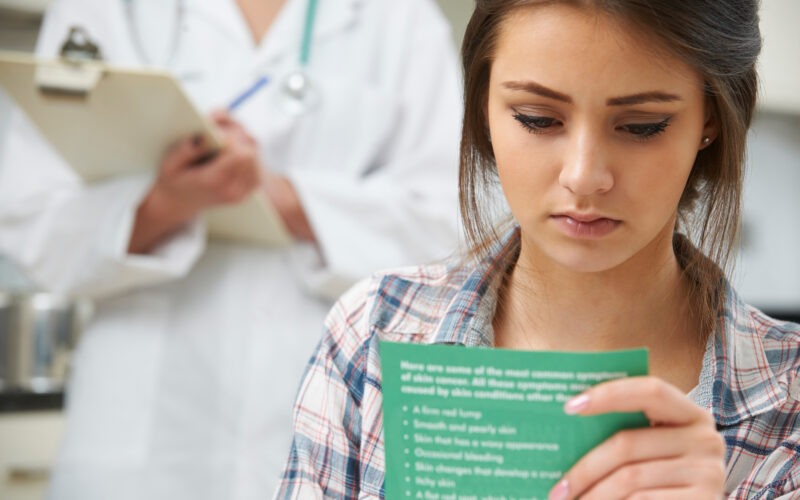A woman’s body is a beautifully—and let’s be honest, sometimes frustratingly—complicated thing. Those who practice fertility awareness know that when it comes to our cycles, little is static: a woman’s hormones are always in motion, causing pain, mid-cycle spotting, and breast tenderness, among other symptoms.
It can all be overwhelming if she doesn’t understand why these things are happening, and unfortunately, too many young women still don’t have information on fertility awareness. Fortunately, over the past few decades, a great deal of research has been done to understand how a woman’s reproductive system works, why symptoms like those mentioned above happen, and how they can be managed with fertility awareness-based methods (FABM).
Most young women understand that a period, or menstruation, is the monthly bleeding that typically lasts 3-7 days, during which the lining of the uterus, or endometrium, is shed from the body. This lining was built up during the course of the previous cycle, in preparation for the implantation of a fertilized egg.
When pregnancy doesn’t happen, a woman can expect her period to start about 28 days (or even up to 35) after the last one did—annoying symptoms and all. If she charts her cycle with a FABM under the guidance of a trained instructor, she can learn when to expect those symptoms and how best to manage them.
1. Ovulation pain
There’s more to the cycle than the period. A critical moment is what’s known as ovulation, that is, the release of an egg from an ovary and into a fallopian tube. (This often happens about 14 days into the cycle, but its timing can vary and thus affect the length of the cycle overall.) Over the course of the egg’s journey, the ovary wall ruptures, which may cause pain. A woman may also experience pain related to the muscular contraction of the fallopian tube, doing its job to help the egg make its way to its destination, the uterus. Pain can range from a momentary twinge to cramping for a few hours or up to two days. Ovulation pain, or mittelschmerz (German for “middle pain”), does not interfere with everyday activities and is usually not cause for concern. It can be treated with over-the-counter pain medication, such as acetaminophen or ibuprofen.
2. Peri-ovulation bleeding
Spotting during ovulation, termed “peri-ovulation bleeding,” is also common and usually no reason to worry. This is another possible side effect of the ovary’s rupturing to release the egg into the fallopian tube. Charting the cycle based on biomarkers such as basal body temperature or cervical mucus can help a woman to identify the day of ovulation and to confirm that this spotting is normal.
3. Breast tenderness
Soreness or heaviness in the breasts often occurs in the last days of a woman’s cycle, just before her period comes. Estrogen, which peaks in the middle of the cycle, causes breast ducts to enlarge, while progesterone, which rises during the last week of the cycle, causes milk glands to swell, both in preparation for a potential pregnancy. As with ovulation pain, this soreness can be treated with over-the-counter medication. Women who experience this symptom may also choose to wear a more supportive bra (even at night); limit caffeine, alcohol, and fatty, salty foods in the week leading up to their periods; and take vitamin E and magnesium supplements to alleviate this symptom.
Other common symptoms include mood swings, bloating, and a heightened sense of smell. These are all related to the hormonal shift that triggers ovulation and are completely normal. When better understood, they can be recognized not as dreaded burdens, but rather as signs that things are working as they should.
Charting a woman’s cycle is more than marking the start of her period on a calendar and then waiting for it to happen again next month. Instead, it’s a system of observing signs her body is offering her—even that annoying pain at ovulation—to reveal what’s going on inside. These symptoms paint a picture of the status of a woman’s reproductive and overall health, starting when she’s a teenager.
The American College of Obstetricians and Gynecologists reports, “Identification of abnormal menstrual patterns in adolescence may improve early identification of potential health concerns for adulthood.” Charting shouldn’t have to wait until a woman is sexually active; there’s a whole lot of important information that can be gained before sex is a factor.
When something’s not right, such as if abnormal levels of PMS pain uncovers a PCOS diagnosis, doctors familiar with FABMs can recommend a management plan aimed at solving the root problem, not covering up symptoms or preventing ovulation from happening altogether, as with the Pill. A holistic approach is also unlikely to have side effects like those associated with hormonal birth control, which, especially in teens, has been linked to depression. And of course, FABMs can also help when a woman is ready and trying to conceive a child.
But the most immediate benefit for young women starting FABMs is to understand that there is a range of “normal” in patterns of bleeding and symptoms associated with menstruation. These will look different for each woman. The sooner a woman is familiar with her patterns, the sooner she and her doctor can use them to make prudent and healthy decisions about caring for her body, both today and in the future.







